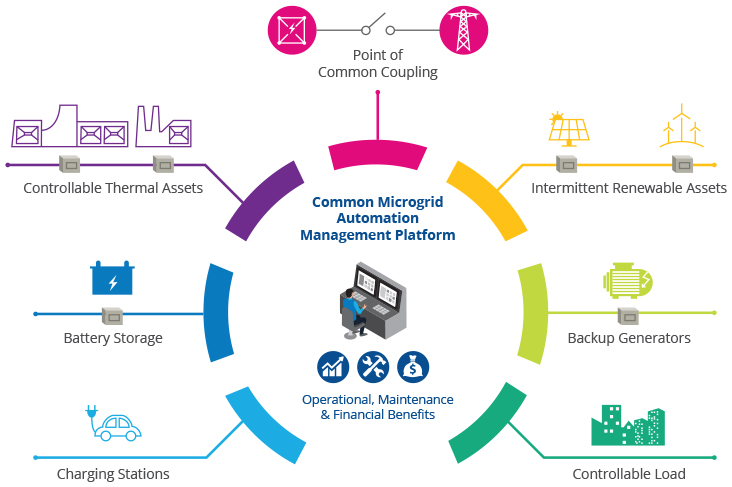Now, more than ever, communities ranging from metropolitan areas to educational or medical campuses need emergency preparedness plans that include contingencies for wide-spread power disruptions or long-term outages caused by unforeseen incidents such as severe storms or wide-spread fires. Microgrids offer one solution to providing reliable, uninterrupted power during emergency events.
Balancing the mix of traditional fossil generators with renewable or alternative assets—each with its own dedicated control and monitoring system—within a microgrid presents unique challenges. Use of multiple, standalone systems limits the broad information-sharing necessary for optimal operational efficiency. This includes sharing the massive amounts of data created from connectivity with the Industrial Internet of Things (IIoT) and converting that data into actionable information. Additionally, each system requires its own set of HMIs, graphics and control standards as well as spare parts, training and service. These factors can hinder operator performance, increase maintenance costs and delay service time.
How do microgrid owners embrace innovation while leveraging existing investments? How do they adapt to new technology without increasing operating and maintenance costs? How can they help their personnel evolve with rapid technology changes?
Implementing a single-platform automation strategy for microgrid management mitigates the inefficiencies of disparate systems and provides numerous operational, maintenance and financial benefits. This is not a new concept: Utilities and independent power producers have a long history of implementing similar strategies with field-proven technologies on the bulk power system to cost-effectively manage vital geographically dispersed generating assets.
By selecting the right scalable, secure platform and services, through a safe supply chain, microgrid owners can digitally transform their operations by leveraging IIoT across their infrastructure. Providing access to better data and digital intelligence can dramatically improve the speed and accuracy of decision-making and actions based on having the right information in the hands of the right expert … no matter where they sit.
An integrated distributed control and SCADA platform efficiently manages a microgrid’s distributed energy assets to cost-effectively produce low-carbon electricity while maintaining grid stability and operational resiliency. A unified system maximizes microgrid resiliency through on-demand, grid-connected and islanded control. It reliably automates control of all microgrid components and macrogrid interconnections to satisfy power demand and maintain stable operating conditions in the event of a macrogrid electrical disturbance. Should a weather or other emergency event disrupt grid operation, customers using this technology can safely disconnect and operate autonomously. When connected, the microgrid can draw supplemental power from the grid if needed or sell excess power back to the grid.
A comprehensive microgrid manager consists of standard integrated functions such as data acquisition, alarm management and historical archiving, as well as embedded energy management and electrical control applications. Energy management strategies optimize power production, power purchasing, energy storage and demand response; protect the microgrid from high macrogrid demand charges and manage energy flow and voltage regulation at the point of common coupling. Electrical applications include breaker control and interfacing with intelligent electronic devices (IEDs), load-shedding (demand management), voltage control and grid synchronization.
Scalable, robust controllers cost-effectively extend the centralized system to widely distributed assets or applications that require direct control near microgrid generators or equipment. The controllers use built-in, flexible networking capability via local or wide-area networks, such as cell or wireless communication technologies, to help manage vital distributed assets. The controllers and associated control strategies can be easily engineered and added to the overall architecture, as needed, to accommodate microgrid additions or process changes. Microgrid owners can leverage existing investments through native data link protocols that connect the platform to a host of Ethernet-enabled devices that are typically provided as part of packaged equipment purchases such as battery management systems and photovoltaic power inverters.
Common HMIs, engineering tools, hardware and software used within that platform enhance operator decision-making by presenting a single comprehensive view of all microgrid processes; simplifies control changes and troubleshooting while enabling in-house maintenance; and reduces maintenance costs associated with spare parts, service and training.
Additionally, cybersecurity programs designed specifically for industrial control system environments can be easily applied to protect common industrial control system equipment and network components. Comprehensive security solutions and services bridge the gap between operational technology (OT) and information technology (IT) to mitigate risk and maintain reliable operation by proactively addressing threats, enhancing protection and streamlining security program management.
Unplanned downtime—the loss of production availability— is one of the biggest causes of reduced profitability, not to mention safety and compliance risk. These unplanned outages result in excessive maintenance, repair and equipment replacement. The ability to incorporate new, transformative technology into a single microgrid management system positions staff as the front-line-of-defense to changing conditions or emerging issues using a proactive rather than reactive approach.
Four of the most significant automation technology developments in this era of digitalization that empower a microgrid’s workforce are analytics, digital twin, mobile and remote work and cloud-based services; all of which can be embedded in a unified automation and software platform. A centralized microgrid manager enables engineering applications in the cloud, viewing of process conditions on a mobile device and optimizing operator performance using analytics and digital twin simulation.
Digital twin simulation enables microgrid owners to test new or updated control and operating strategies in a reliable, risk-free environment that mirrors real-life operating conditions. Cloud-hosted digital twin and engineering services supplement limited onsite resources and reduce maintenance burdens. This is possible by allowing the automation provider to establish and manage an easily accessible cloud-based simulator or engineering environment.
Advanced analytics transition customers from a reactive operations and maintenance approach to a predictive or prognostic strategy, which helps extend equipment life and reduces overall costs while increasing plant safety, reliability and availability. Analytical solutions bring together the automation platform, an intelligence framework and prognostic applications to deliver advanced diagnostics that identify impending process upsets or equipment anomalies and trigger mitigating action to avoid downtime or catastrophic damage. Prognostic advanced applications provide complex modeling, artificial intelligence, based on advanced pattern recognition (APR) and machine learning functions while interacting with an intelligence framework and data from the automation platform. Collectively, they alert and guide operators to take immediate, specific action or direct the control system to do the same to avert future, potentially catastrophic equipment or process failures.
Integrated enterprise data solutions provide microgrid staff secure, remote access to enterprise-wide key performance indicators, enabling them to make well-informed decisions that can improve operations and reduce costs. Mobile deployment enables on-demand process monitoring from virtually anywhere to assist onsite operators with decision-making.
As technology advances and interest in energy independence and renewable generation grows, microgrids are becoming more prevalent. And as they gain traction, they will begin to reshape the power generation sector. An integrated automation platform can play an important role in helping organizations operate their microgrids more efficiently and reliably.

Implementing a single-platform automation strategy for microgrid management mitigates the inefficiencies
of disparate systems and provides numerous operational, maintenance and financial benefits.
 Rick Kephart is the vice president for software solutions at Emerson’s power and water solutions business. He joined the organization (then known as Westinghouse Process Control) as a field engineer in 1990. In his current position, he manages a global organization responsible for the development of all software related to the Ovation™ automation platform. He holds a B.S. in electrical engineering from Penn State University and an M.S. in electrical engineering from the University of Pittsburgh. He currently is pursuing a Ph.D. in electrical engineering from the University of Pittsburgh.
Rick Kephart is the vice president for software solutions at Emerson’s power and water solutions business. He joined the organization (then known as Westinghouse Process Control) as a field engineer in 1990. In his current position, he manages a global organization responsible for the development of all software related to the Ovation™ automation platform. He holds a B.S. in electrical engineering from Penn State University and an M.S. in electrical engineering from the University of Pittsburgh. He currently is pursuing a Ph.D. in electrical engineering from the University of Pittsburgh.







